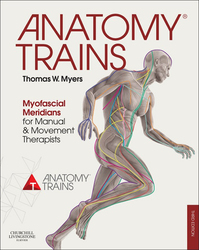「重要なお知らせ:日本語書籍をご購入いただき、eLibraryをご利用の皆さまへ」
エルゼビアは、より快適にサービスをご利用いただくため、システムの重要なアップデートを実施いたします。
現在、新サイト、eBooks+への移行が進められています。
新規ユーザー登録および書籍の登録はElsevier eLibraryでは停止しております。
12月15日以降に
こちらよりご利用・ご登録ください。
Anatomy Trains






Book Description
The new edition of this hugely successful book continues to present a unique understanding of the role of fascia in healthy movement and postural distortion which is of vital importance to bodyworkers and movement therapists worldwide. Fully updated throughout and now with accompanying website (www.myersmyofascialmeridians.com), Anatomy Trains: Myofascial Meridians for Manual and Movement Therapists will be ideal for all those professionals who have an interest in human movement: massage therapists, structural integration practitioners, craniosacral therapists, yoga teachers, osteopaths, manual therapists, physiotherapists, athletic trainers, personal trainers, dance and movement teachers, chiropractors and acupuncturists.
- Provides a revolutionary approach to the study of human anatomy which has been shown to improve the outcomes of physical therapies traditionally used to manage pain and other musculoskeletal disorders
- Describes a theory which is applicable to all common types of movement, posture analysis and physical treatment modalities
- Layout designed to allow the reader to gather the concept quickly or gain a more detailed understanding of any given area according to need
- Design icons direct readers to their own specialist areas of interest, e.g. manual therapy, movement therapy, visual assessment, kinaesthetic education or supplementary video material
- Appendices discuss the relevance of the Anatomy Trains concept to the work of Dr Louis Schultz (Meridians of Latitude), Ada Rolf (Structural Integration) and the practice of Oriental Medicine
- Accompanying website (www.myersmyofascialmeridians.com) presents multi-media exploration of the concepts described in the book - film clips from Kinesis DVDs, computer graphic representations of the Anatomy Trains, supplementary dissection photographs and video clips, webinars, and some extra client photos for visual assessment practice
- Text updated in relation to the most up-to-date research originally published at the International Fascia Research Congress, Vancouver, 2012
- Includes the latest evidence for the scientific basis of common clinical findings, including preliminary evidence from human fascial dissections
- Explores the role of fascia as our largest sensory organ
- Contains updates arising out of continual teaching and practice – for example, the role of the fascia and its interconnectivity in the generation of pain and/or force transmission
- New chapter discusses the role of Anatomy Trains theory in the analysis of gait
- Video clips on an associated website (www.myersmyofascialmeridians.com) present examples of the concepts explored in the book
- Podcasts on the website explore the therapeutic techniques involved
- Website addresses and references fully updated throughout


 (0 rating)
(0 rating) 